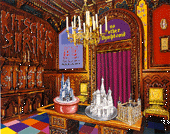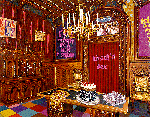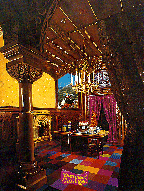 Entering
the kitchen in reverse II, oil on canvas, 168.0 x
213.0 cm, 1996
|
Central to Suzanne
Treister's multi-media installation, Kitsch 'n Shrink
are a sequence of large paintings. Overall
Treister’s works are realised in photomedia, text,
oil painting and computer generated work. With titles
such as Entering the kitchen from afar and Standing
on the wall looking down onto the kitchen floor of the
castle the set of sumptuously rendered, wet-on-wet
oils re-writes the baroque interior of King Ludwig's
Bavarian castle, the Königsschoß Neuschwanstein, as a
narrative of postmodernism. The interior architecture
of Ludwig's study is renovated conceptually as a semiotic
chain-mail of cultural narratives woven together through
a cross-referencing series of linguistic and visual puns.
The representational space, the conceptual interface
might be read as hypertextually linking multitudinous
sets of iconographies and contesting discourses. The
spectator is bombarded by a seemingly endless stream of
all too familiar cultural narratives - folkloric,
fairytale, gothic, historical, mythological,
technocultural, filmic, kitsch, sexual - rhizomatically
connected through a series of visual and linguistic gags.
In this spectatorial space, this monumental feat of
pastiche, time could be said to have been collapsed into
the present. The spectator might be caught in a
bricolaged nightmare where unravelling any of the
narrative threads and representational motifs in this
metaphor of cyberspace becomes a game of severe
commitment - or of chance.
|
 Entering the
kitchen in reverse, oil on canvas, 168 x 213 cm, 1996
|
In chess 'to castle' is to
move the king two squares sideways and place the nearer
rook (same as castle) on the square passed over by the
king. If the King is passed over (dead) who or what might
be said to inhabit the vacated schloss? In Treister's
hyperreal vision the castle could be said to be haunted
by the promiscuity of (imaginary) proletarian pleasure -
a Hammer horror narrative of gothic intrigue, conflict,
desires and anxieties. The fortified castle, read as an
iconic representation of a model of eurocentric medieval
feudalism and/or anglocentric colonial imperialism (as
you wish) morphs, painterly fashion, into a multiply
penetrated site of popular postmodern pleasures (cherry
topped Black Forrest cake, a miniature ice palace, s/m
fetish paraphernalia, portraits of David Bowie as Aladdin
Sane). |
 Entering the kitchen from afar, oil on
canvas, 213.0 x 168.0 cm, 1996.
|
The writing on the wall -
doughnut (linguistically) morphs into salami - figures
the fantasmic site/scenario for both the disintegration
of the King's heritage and the points of entry for
narratives of science, history, popular culture, and
'perverse' sexuality. This set of viscerally painted
images frame a virtually real space in which the castle
study/kitchen walls are made of gruyere - shot through
with holes; Jack Nicholson as the Joker from Batman
replaces the dynastic lineage portraits of feudal
robber-barons; and a splendidly detailed maquette of the
castle (King Ludwig's of Bavaria) is painted to resemble
jello dildos. Within this generative matrix - this
hypertextual chora - Christo-wrapped objects (a maquette
of the Reichstag, a display plate on a dresser) and a
Daliesque jewel- studded omelette sliding relentlessly
towards the kitsch'n floor suddenly appear in the object
saturated room. A heavily curtained doorway promises a
possible exit, coded in silver studs on leather, via the
'scenic route.' As Richard Grayson might say, the
monarch(y) as a rule(r), appears to have either been
buggered or to have buggered off in Treister's work. As
with any cyberspatial tourist paradise and/or site of
'paranoid nostalgia' one enters this metaphorical castle
at one's peril.
Jyanni Steffensen
1996
|